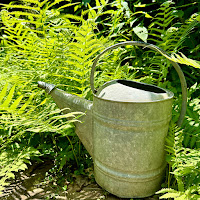Yes! – how much and how often depends on circumstances (read on for what you should consider). Here we are – just barely into summer – and brutal temps are already upon us. Frankly, it feels like most of spring was summer, but that’s another topic.
As
we hide indoors, sipping on cool drinks and running the fans, how are our
plants faring and should we do anything for them (after all, they are native
plants, right?).
Should we water them? Let’s explore some of several reasons
why that answer should be “Yes.”
1. Are they newly planted? I’ll extend that definition to something you planted this year and within the last 12 months. Plants that grew in pots, tenderly watered until you bought them, may not have had time to establish extensive enough roots to withstand temperatures like 96 degrees. Mulching helps but if they are drooping or crisping up, they need water.
2. Gardens are man-made constructs and plants don’t always have the support system they might have in the wild – mycorrhizal and fungal networks that help roots function more efficiently – so recognize that our gardens might still need human assistance during hard times.
3. Plants in pots dry out faster than plants in the ground.
4. Patterns of rain don’t always reach plants in areas near structures. Evaluate if your foundation area plants are getting enough water even when we get afternoon thunderstorms.
 |
| This is an afternoon picture; this jewelweed usually perks up by morning. |
When to check? Check any time of day, but know that they absolutely need water if they are droopy in the morning. Plants can recover overnight so if they are wilted in the morning then they don’t have enough resources to recover. To ensure that visibly stressed plants get water, I take the time to hand water them rather than chance that the spray from the hose or sprinkler gets there.
When to water? Most people know that watering in the heat of
the day is not productive. The water evaporates too quickly and you’ll have a
false sense of how much the plants got. Watering in the morning is ideal when
soil might be a little softer and able to soak it in; watering in the evening
is second best and there is some risk of causing fungal issues due to overnight
damp foliage (but if that is the only time you can do it, then just be aware of
that and go ahead and water).
And while you’re watering your plants, consider leaving out sources of water for birds and other critters. I recently put my hummingbird feeder back up and was happy to see one young female taking long and refreshing sips at it. Refresh these every other day if you can (I read that sugar water spoils quickly in temperatures over 90 degrees and the spoiled syrup can be harmful).










